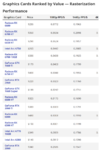I went from a 1070 to an amd rx 5700 xt card, and found that the only way to get it to run stable was to install the drivers but not the catalyst software. It was causing crashes, overheating, odd performance issues the works. I was on their site for months trying to figure it out when someone showed me how to install just the drivers, and poof everything was fine.
I am agnostic generally when it comes to hardware, and will give companies a shot every few generations...but that doesn't change that there were severe documented issues with recent software that was auto installed when installed drivers. I am not a fan boy making that up.
Well, now that you've given some context, it makes more sense and I believe you because I had terrible issues with my RX 5700 XT. The thing is, it turned out to not be the drivers. I was getting power-off resets with loud buzzing green screens. I remember thinking to myself "Drivers can't cause a power-off reset, they can just crash to the desktop." and so I was mystified.
I decided to try an experiment. I pulled the RX 5700 XT out of my PC and put my R9 Fury back in and kept the same drivers installed because they supported both cards. When I did that, all the instability immediately ceased. If the drivers had been the problem, the R9 Fury wouldn't have been stable either but it was rock-solid. I RMA'd the card with XFX and those monkeys sent me a replacement with a VRAM error so I had to RMA it again and I made sure to let them know that THEY were paying ALL of the shipping this time around. I remember wanting to strangle whoever was stupid enough to send back another defective card but I kept my cool because yelling doesn't get anyone anywhere. It turned out that keeping my cool was the right decision.
The model I had purchased was the XFX RX 5700 XT Triple Dissipation, which was a basic model. I always buy basic models because I don't feel like spending an extra $100 for
maybe a 3% performance uplift. Well, the one they sent me back was one of their upscale models called the THICC-III. When installing it, I immediately noticed that instead of having one 8-pin connector and one 6-pin connector like the Triple Dissipation, it had two 8-pin connectors. I'm thinking that the 8+6 must have been insufficient for the GPUs power needs and XFX just basically screwed it up.
What really puzzled me was that no reviewers had encountered these problems with the cards. Then I realised that reviewers generally only get upper-level cards like Powercolor Red Devils, Sapphire Nitros, XFX THICC-III's and ASUS TUF or ROG Strix models. You never see them with models like Gigabyte Eagle, ASRock Challenger or Powercolor Fighter models. I think that maybe the problem there was that the upper-level models all had 8+8 connectors so the power issue wasn't there.
I have no doubt that you experienced problems with your RX 5700 XT but I do seriously doubt that it was the drivers. Through all of this, I didn't change the installed drivers because the R9 Fury was fine with them and I still wasn't sure that it wasn't the drivers. I can safely say now however that it wasn't the drivers at all because when I slapped that THICC-III into my PC, with the
exact same drivers that the Triple Dissipation had, the THICC-III was as rock-solid as my R9 Fury Nitro.
The same driver package that I used is more than likely the same driver package that you used. If it was rock-solid in my rig, then I have to assume that you, like me, had a hardware problem that appeared to be a driver problem and if I didn't know what I know, then I would've assumed it was the driver as well. That's just normal because driver issues tend to be more common than issues of other kinds and if the odds seem to be that it's the drivers, then who can blame people for making that assumption? Certainly not me and I also don't blame people for not wanting to deal with issues like that because who would want to?
There are so many things that can go wrong that appear to be the video driver but really aren't. The last time I had any driver issues that I can remember were with my twin Gigabyte HD 7970s in Crossfire and it was just that the screen sometimes scaled larger than my display so things were cut off at the edges of the screen. All I had to do to fix that was bring up the Catalyst screen and toggle GPU scaling. I had to do it about twice a week and it was somewhat annoying but nothing that was truly bothersome.
As I look back, I can honestly say that I've never had any issues with Adrenalin drivers. I did have a Windows update (of all things) that caused some screen-tearing and it forced me to go back to the previous driver package but I know that was Windows' fault because everything was fine before that update. A lot of people would have probably defaulted to blaming the Adrenalin driver for that and I wouldn't blame them. I even came across one person who had issues that they wanted to blame on the Adrenalin driver n a build they did because they were getting really low FPS. I took a look at their system and the dumb tool hadn't installed the X470 Chipset drivers for his motherboard. What a gonk!
😆


